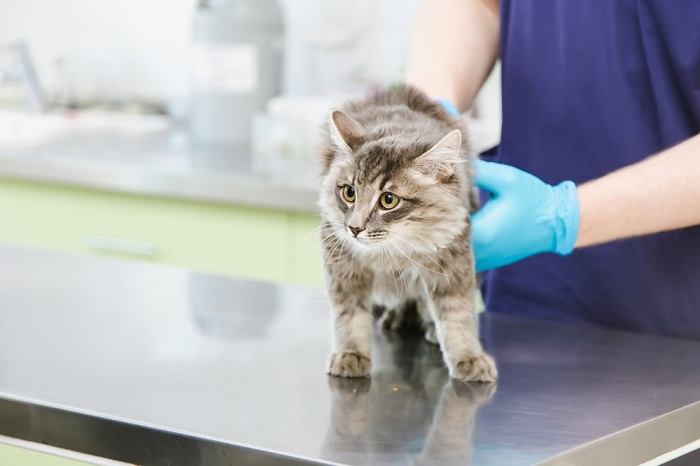
Shutterstock.com
Fleas are infamous for passing diseases to their animal hosts. They can even pass dangerous bacteria, such as Bartonella, onto unsuspecting cats.
Bartonella is the name for several similar bacteria that can infect cats and lead to illness in people known as “cat scratch disease” or “cat scratch fever.” In this article, you’ll learn what Bartonella is and the effects it may have on both cats and people.
Quick Overview: Bartonella in Cats






What Is Bartonella in Cats?
There are several similar bacteria with the Bartonella name. Bartonella henselae is the most common Bartonella species carried by cats.[4] It has also been known to cause cat scratch disease in people.
While there are 14 species of Bartonella that can cause diseases in people, only five are carried by cats. Besides Bartonella henselae, Bartonella clarridgeiae may also be involved. The other three species carried by cats rarely cause infection.
Causes of Bartonella in Cats
Bartonella is primarily transmitted to cats by fleas (Ctenocephalides felis). The bacteria can be present inside the flea. When the flea bites a cat, the bacteria can be transmitted into a cat’s bloodstream. Ticks may also be a potential vector. Tick transmission has not been studied as well, but is thought to be much less common.[9]
The bacteria can also be present in flea dirt, which is another name for flea feces. Flea dirt is essentially digested blood that the flea excretes after feeding on a host animal like a cat. If flea dirt enters an open wound, this is another way Bartonella can infect a cat.
While a rare cause, a cat could also get infected with Bartonella if given a blood transfusion with blood from a cat that already carries the bacteria in their bloodstream.
Symptoms of Bartonella in Cats
Most cats that have been infected with Bartonella show no symptoms. Some studies estimate that up to 30-60% of cats in the US may be asymptomatically infected at some point in their lives.[2]
Bartonella henselae especially is very host-adapted to the cat. This means that it can infect a cat without causing any signs of disease.
If a cat does get sick from a Bartonella infection, the most common result will be a temporary fever lasting 2–3 days.[7]
Kittens less than six months of age are more likely to develop an active Bartonella infection compared to adult cats.[2] Cats less than 2–3 years of age are more likely to have bacteremia, or Bartonella bacteria, in their bloodstream. Many of them will show no signs of illness.[9]
It is possible for cats to carry the bacteria actively in their bloodstream for several months or even years at a time.
Complications of Bartonella
While rare, a cat may show more serious clinical signs of illness when infected with Bartonella. These signs can include:
- Fever
- Vomiting
- Diarrhea
- Lethargy
- Decreased appetite/anorexia
- Eye inflammation
- Enlarged lymph nodes
- Muscle aches or pain
- Reproductive failure
- Neurologic disease
- Endocarditis (bacterial deposits on heart valves causing heart disease)
Diagnosis of Bartonella in Cats

Your veterinarian will conduct a thorough exam to confirm a Bartonella diagnosis. Shutterstock.com
Diagnosis of Bartonella in cats can be tricky. There are a couple of different tests that can be used that provide different information.
1. Blood Culture
A blood culture is the most definitive way to detect Bartonella bacteria since they reside in the bloodstream. Cultures can also be obtained from an abnormal lymph node or an affected heart valve.
But the bacteria in infected cats may not always be detectable in the bloodstream. The cat may have Bartonella but the bacteria is not in sufficient quantities in the bloodstream to be detected. So it is possible for a culture to have a false negative result.
Culture samples can also be difficult to obtain and may take at least several days to return results.
2. Polymerase Chain Reaction (PCR)
Another method is by PCR. This method detects actual Bartonella DNA. This means the PCR is only likely to be positive if the bacteria is actually present. PCR is much less invasive, results return faster, and it is still a very sensitive test method.
However, a disadvantage to PCR is that, like the blood culture, a false negative result may occur if a cat does not currently have sufficient numbers of Bartonella bacteria in the bloodstream to detect.
3. Immunofluorescent Antibody (IFA)
IFA is a way of detecting antibodies that a cat’s body has produced in response to Bartonella infection. This method works very well for detecting cats that have been exposed to Bartonella.
However, a cat that has produced antibodies is not necessarily currently infected with bacteria in the bloodstream. Cats with really early infection may also have negative IFA testing because sufficient antibodies haven’t been produced yet.
IFA testing is best for ruling out Bartonella as a concern for infection or transmission to people. So while a cat with a positive antibody test may or may not have an active infection, a cat with a negative antibody test is very unlikely to have Bartonella currently or previously at all.
Treatments for Bartonella in Cats
Treating cats for Bartonella is somewhat controversial. Most cats infected with Bartonella exhibit no signs of illness and are otherwise healthy. A majority of those who do get sick have a mild, temporary illness lasting less than a week.
The one exception where treatment would be considered is a cat with one or more serious signs of illness where Bartonella has been proven to be the cause through testing.
In this case, treatment with one of several antibiotics may be recommended. There is no one antibiotic proven best for treating Bartonella, but ones that have been used include:
- Doxycycline
- Tetracycline
- Erythromycin
- Amoxicillin/clavulanic acid (Clavamox)
- Rifampin
- Enrofloxacin
- Azithromycin
Sometimes a combination of two antibiotics may be used. Antibiotic therapy for Bartonella in cats is longer than for some other infections. Treatment for 4-6 weeks is typical.[8]
When treating a cat, the goal is to significantly reduce the presence of Bartonella bacteria in the bloodstream. This may lead to an improvement in some symptoms with the exception of more serious forms of disease.
It may not be possible to completely eliminate Bartonella from a cat’s body. There is no specific antibiotic, antibiotic dose, or length of treatment that has proven to completely clear infection. Cats that have been treated with antibiotics may develop relapses where Bartonella multiplies in the bloodstream again at a later time.
Because of this and because Bartonella can quickly develop resistance to antibiotics being used, prophylactic or empirical treatment of a healthy cat with Bartonella is rarely advised.
Cat Scratch Disease in People

Shutterstock.com
Cat scratch disease can be transmitted to a person if a cat scratches them with claws contaminated with Bartonella bacteria. It is also possible for a bite to cause this if Bartonella bacteria is present in the mouth. It could even happen if a cat licks an open wound on a person’s skin.
In healthy people, the area where the scratch occurred will develop a small swelling called a papule that appears red and crusty. Within another two weeks, lymph nodes closest to that area will swell and become painful. A fever also typically develops, lending to the alternate name “cat scratch fever”.
While uncomfortable, these Bartonella signs typically resolve on their own and most people make a complete recovery. Lymph node swelling may persist for a few months.[6]
In people with a compromised immune system, cat scratch disease can have more severe consequences that include:
- Neurologic disease (encephalitis, seizures, paraplegia)
- Eye problems (retinitis, conjunctivitis)
- Spleen enlargement
- Endocarditis (infection of heart valves)
Antibiotics are usually only prescribed for people who have a compromised immune system and risk of more severe disease.
Cat Care Tips
In most cases, cats with Bartonella show no signs of illness and no special care is required. Even a cat confirmed to have Bartonella or previous exposure may need no treatment if there are no signs of illness.
If cats develop any signs of more serious illness, having this evaluated by a veterinarian is very important. Many of the more serious symptoms of Bartonella in cats can also be seen with other illnesses. It is important for a veterinarian to help you rule out other causes.
Prevention of Bartonella in Cats
To keep your cat and your family at a lower risk of contracting Bartonella, consider the following tips:
- Keep your cat indoors
- Use an appropriate flea prevention medication year-round
- Keep your cat’s nails trimmed (at least for indoor cats)
- Wash any fresh cat scratches on your skin immediately with soap and water
- If you develop any signs of illness after getting scratched by your cat, seek medical attention
Frequently Asked Questions
Is Bartonella in cats curable?
This is not known for sure, but it may not be possible to fully eradicate Bartonella from a cat’s system. Treating Bartonella in cats with antibiotics is aimed at significantly reducing Bartonella bacteria in the bloodstream. This will hopefully lead to improvement in any signs of illness.
However, cats treated this way for Bartonella can often have relapses where the bacteria multiply in the bloodstream again months or years later. While there are several antibiotics that can be used to treat Bartonella, there is no one antibiotic or protocol proven to eliminate the bacteria completely.
What does Bartonella cause in cats?
Most cats with Bartonella show no signs of illness. The most common symptom is a mild fever that resolves on its own in a couple days.
Serious signs of illness are uncommon in otherwise healthy cats but can occur in young cats and kittens. Other signs include lymph node enlargement, lethargy, digestive upset, eye inflammation, and abnormal neurologic behavior.
What Happens if Bartonella Goes Untreated in Cats?
In many cases, nothing at all will happen. Cats may carry the Bartonella bacteria in their bloodstream for months or years with no ill effects. Treating asymptomatic cats is controversial as a complete cure of infection may not be possible and Bartonella can quickly develop antibiotic resistance.
In the case of cats with more serious signs of illness confirmed to be caused by Bartonella infection, treatment should be attempted as signs of illness may improve.
Can indoor cats get Bartonella?
Indoor cats are at a lower risk of Bartonella because it's primarily transmitted by flea bites—but they're not immune to fleas. Fleas can get inside on clothing or from another pet that goes outside. Use of a flea prevention product year-round is the best way to prevent a flea infestation or transmission of a flea-borne disease.
An indoor cat may also have Bartonella if they contracted the disease as a young cat or kitten. Cats can harbor the bacteria for months or years without showing signs of illness.
-
Álvarez-Fernández, A., Breitschwerdt, E.B. & Solano-Gallego, L. Bartonella infections in cats and dogs including zoonotic aspects. Parasites Vectors 11, 624 (2018). https://doi.org/10.1186/s13071-018-3152-6
-
Bartonella henselae. Auburn University College of Veterinary Medicine. Accessed September 21, 2023. https://www.vetmed.auburn.edu/academic-departments/dept-of-pathobiology/diagnostic-services/molecular-diagnostics/bartonella-henselae
-
Avital Lily Okrent Smolar, Edward B. Breitschwerdt, Paul H. Phillips, Nancy J. Newman, Valérie Biousse. Cat scratch disease: What to do with the cat? American Journal of Ophthalmology Case Reports, Volume 28, 2022, 101702, ISSN 2451-9936. https://doi.org/10.1016/j.ajoc.2022.101702.https://pubmed.ncbi.nlm.nih.gov/36147775/
-
Brooks, W. Bartonella and Cat Scratch Fever. Veterinary Partner. Published November 24, 2003. Revised August 29, 2023. Accessed September 21, 2023. https://veterinarypartner.vin.com/default.aspx?pid=19239&catId=102903&Id=4952003
-
Burns, K. Bartonellosis: A zoonosis hidden in plain sight. JAVMAnews. Published June 1, 2021. Accessed September 21, 2023. https://www.avma.org/javma-news/2021-06-01/bartonellosis-zoonosis-hidden-plain-sight
-
Bush, L.M., Vazquez-Pertejo, M.T. Cat-Scratch Disease (Cat Scratch Fever). Merck Manual Professional Version. Revised April 2022. Modified September 2022. https://www.merckmanuals.com/professional/infectious-diseases/gram-negative-bacilli/cat-scratch-disease
-
Centers for Disease Control and Prevention. Bartonella Infection (For Veterinarians). Last reviewed January 23, 2020. Accessed September 21, 2023. https://www.cdc.gov/bartonella/veterinarians/index.html#:~:text=Cats%20may%20also%20harbor%20Bartonella,more%20at%20risk%20for%20infection.
-
Centers for Disease Control and Prevention. Bartonella henselae infection or cat scratch disease (CSD). Last reviewed January 10, 2022. Accessed September 21, 2023. https://www.cdc.gov/bartonella/bartonella-henselae/index.html
-
Guptill, L. What do we really know about feline bartonellosis (Proceedings). DVM360. April 1, 2009. Accessed September 21, 2023. https://www.dvm360.com/view/what-do-we-really-know-about-feline-bartonellosis-proceedings
-
Weir, M., Williams, K., Ward, E. Cat Scratch Disease (CSD). VCA Animal Hospitals. Accessed September 21, 2023. https://vcahospitals.com/know-your-pet/cat-scratch-disease







